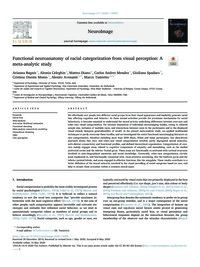Mostrar el registro sencillo de la publicación
Functional neuroanatomy of racial categorization from visual perception: a meta-analytic study
| dc.contributor.author | Bagnis, Arianna | |
| dc.contributor.author | Celeghin, Alessia | |
| dc.contributor.author | Diano, Matteo | |
| dc.contributor.author | Méndez, Carlos | |
| dc.contributor.author | Spadaro, Giuliana | |
| dc.contributor.author | Onesta-Mosso, Cristina | |
| dc.contributor.author | Avenanti, Alessio | |
| dc.contributor.author | Tamietto, Marco | |
| dc.date.accessioned | 2020-08-28T16:38:05Z | |
| dc.date.available | 2020-08-28T16:38:05Z | |
| dc.date.issued | 2020 | |
| dc.identifier.uri | http://repositorio.ucm.cl/handle/ucm/3053 | |
| dc.description.abstract | We effortlessly sort people into different racial groups from their visual appearance and implicitly generate racial bias affecting cognition and behavior. As these mental activities provide the proximate mechanisms for social behaviours, it becomes essential to understand the neural activity underlying differences between own-race and other-race visual categorization. Yet intrinsic limitations of individual neuroimaging studies, owing to reduced sample size, inclusion of multiple races, and interactions between races in the participants and in the displayed visual stimuli, dampens generalizability of results. In the present meta-analytic study, we applied multimodal techniques to partly overcome these hurdles, and we investigated the entire functional neuroimaging literature on race categorization, therefore including more than 2000 Black, White and Asian participants. Our data-driven approach shows that own- and other-race visual categorization involves partly segregated neural networks, with distinct connectivity and functional profiles, and defined hierarchical organization. Categorization of own-race mainly engages areas related to cognitive components of empathy and mentalizing, such as the medial prefrontal cortex and the inferior frontal gyrus. These areas are functionally co-activated with cortical structures involved in auto-biographical memories and social knowledge. Conversely, other-race categorization recruits areas implicated in, and functionally connected with, visuo-attentive processing, like the fusiform gyrus and the inferior parietal lobule, and areas engaged in affective functions, like the amygdala. These results contribute to a better definition of the neural networks involved in the visual parcelling of social categories based on race, and help to situate these processes within a common neural space. | es_CL |
| dc.language.iso | en | es_CL |
| dc.rights | Atribución-NoComercial-SinDerivadas 3.0 Chile | * |
| dc.rights.uri | http://creativecommons.org/licenses/by-nc-nd/3.0/cl/ | * |
| dc.source | NeuroImage, 217, 116939 | es_CL |
| dc.subject | Racial bias | es_CL |
| dc.subject | Meta-analysis | es_CL |
| dc.subject | Activation likelihood estimation | es_CL |
| dc.subject | Functional decoding | es_CL |
| dc.subject | Meta-analytic connectivity modeling | es_CL |
| dc.subject | Hierarchical clustering | es_CL |
| dc.subject | fMRI | es_CL |
| dc.subject | Face perception | es_CL |
| dc.title | Functional neuroanatomy of racial categorization from visual perception: a meta-analytic study | es_CL |
| dc.type | Article | es_CL |
| dc.ucm.indexacion | Scopus | es_CL |
| dc.ucm.indexacion | Isi | es_CL |
| dc.ucm.doi | doi.org/10.1016/j.neuroimage.2020.116939 | es_CL |



